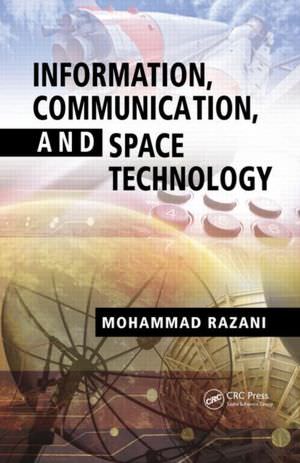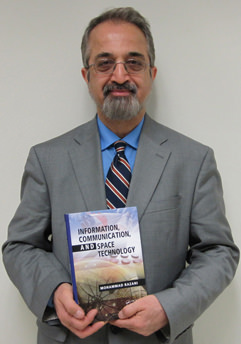I was worried that the book “Information, Communication and Space Technology” had the potential to be ‘jack of all trades, master of none,’ as it promises to cover all aspects of ICT and space tech, all in 200-ish pages. But I needn’t have worried. Author Mohammad Razani delivers on the ambitious goal of presenting a high level picture on all topics of Information Communication Technology(ICT) and space technology.
Although at times it seems as though there is a distinct split between the ICT and the space tech content, the author presents his information in a manner which most tech-heads and gear-geeks would love. But this book is not for the average fiction-inclined reader. Some previous knowledge is required.
It begins with covering the very large topic of ICT in health, government and education. At times it feels as though this half of the book is there to balance to latter space tech half of the book, like a student presenting the ‘boring bits’ before going crazy about ‘space technologies!!!’. He does skim over some points a little, but this keeps it interesting and exciting because it doesn’t get bogged down in the fine details. This means the book is not too overwhelming, but it remains informative by presenting enough detail.
There is the potential for some of the content to be interpreted as opinion piece…which at times it kind of is. He presents arguments for further resources and investment into ICT in education, particularly in the USA, where he is an educational professional. However, it’s presented objectively and doesn’t read as though he is shouting from the soap box. And there are enough references cited for each point he makes to make each argument objective (if that is not an oxymoron). He presents cases studies, tables and stats for the numerically-minded readers and is a reflection of past ICT and statistics to dictate possible direction of future ICT. Mohammad Razani presents studies on what challenges there are in ICT for health, gov and education, and the possible future solutions through case studies. Not being previously familiar with a lot of the industries issues he covered, I’ve learnt a great deal.
The information presented was very detailed and pleasing for the techno-geek audience. But at times was difficult to understand the information the author uses for comparison. For example, tables on satellites from different agencies presented different measurements and specifications, making it like comparing apples with oranges.
And there seemed to be a couple of product placement mentions — e.g. the software workshop the author attended. Perhaps I am cynical, but it seemed to be like when a doctor presents a certain drug, because he gets kickbacks from the pharmaceutical company.
The space technology section was more well thought-out and exciting. You could tell that Mohammad Razani was more inspired by these topics. He gave a great background on the history and development of the space technology and satellites. The cool parts were definitely the brief scientific explanation of space flight, atmospheric studies and gravity. It kept the pages turning without becoming overwhelming. I felt I learnt a great deal without the aid of any other research or references.
Tip: start your own glossary to refer to. This reader would have benefited from a glossary, instead of having to refer to the index or re-read parts of the book where the definitions and explanations of acronyms and phrases were presented.
The highlights of this book were the scientific explanations of the relevant to content. If a reader was so inclined to do self-research on this topic, it would take them years to find all information presented in this book, without the guidance Mohammad Razani. As a reader, I am left with the hope that ICT could be used to advance all of humanity, rather than promote western culture alone. As a student this has inspired me to pursue this area of technology, as we have only just begun. It gives a great starting point for any interested readers to launch their own research and further reading. I will refer to this book for years to come. The hardcover is also a bonus!
If I had to give this book a rating, it would be 3.5 satellite dishes out of 5.



Please note that Mohammad Razani is chairperson of the Department of Electrical and Telecommunications
Engineering Technology at New York City College of Technology (City
Tech) of The City University of New York.